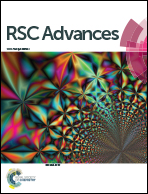Pyrene-based BODIPY: synthesis, photophysics and lasing properties under UV-pumping radiation†
Abstract
The synthesis, photophysical and laser properties of a pyrene-based tetramethyl difluoroboron-dipyrromethane (PYBDP) are reported in the present paper. The PYBDP presents a higher fluorescence quantum yield and Stokes shift than other phenyl-substituted laser dyes in the green region. Under transversal pumping conditions, the new dye exhibits highly efficient and stable amplified spontaneous emissions centering at 531 nm. Moreover, the new dye presents a maximum narrow band ASE lasing efficiency of 10.86% with a wide tunable range (525 nm to 560 nm) on excitation with a Q-switched Nd:YAG (355 nm) laser in toluene.


 Please wait while we load your content...
Please wait while we load your content...